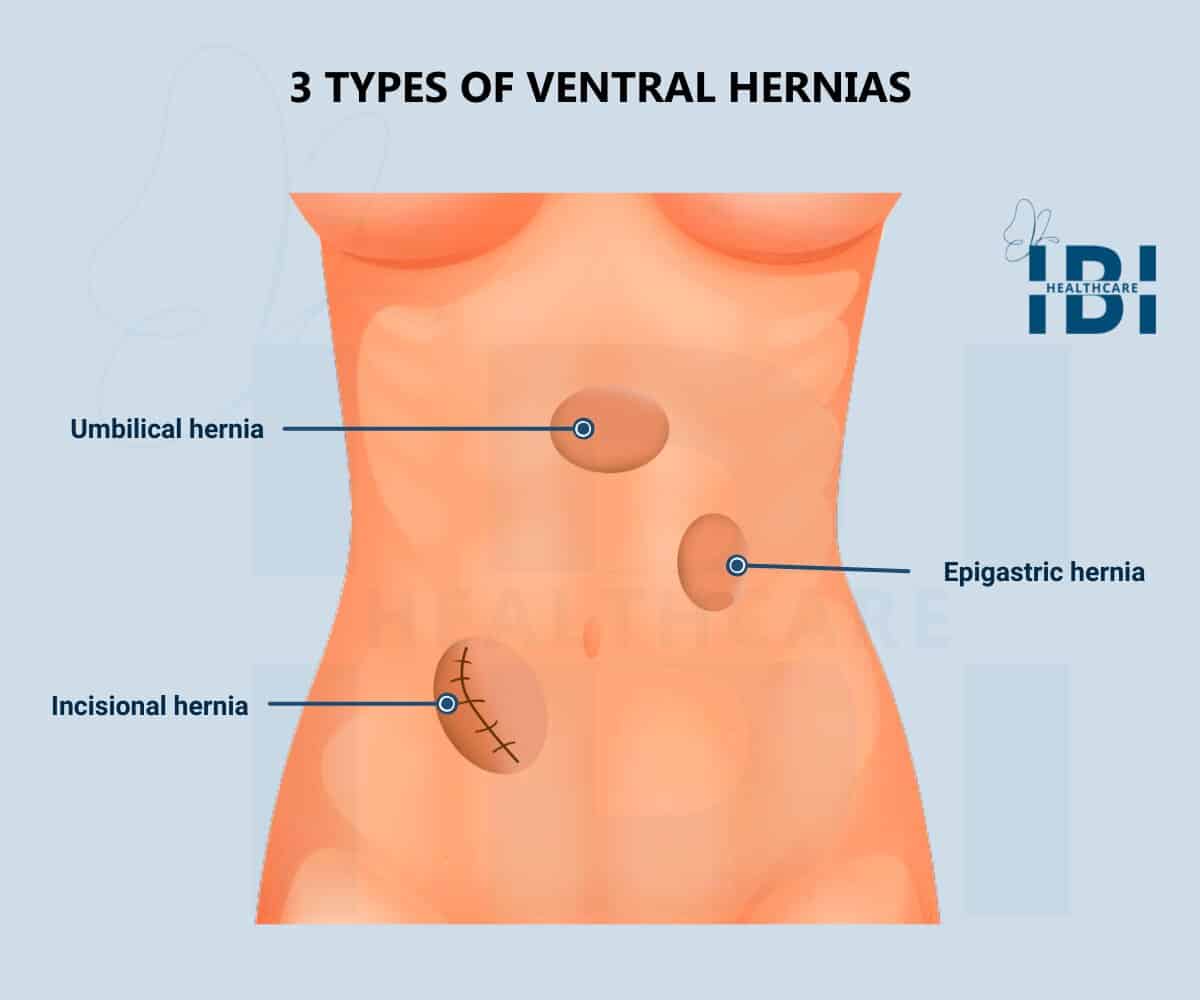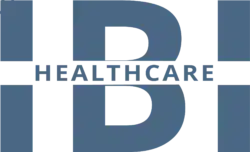What is a Ventral Hernia?
When a separation or hole is present in the abdominal wall, it can allow abdominal tissue. Such as part of an intestine, to push out through this hole forming a hernia. However, if the hernia positions itself in the vertical center of the abdominal wall. It is classified as a ventral hernia. Furthermore, ventral hernias break down into three categories, which include:
Epigastric Hernia
- Found in both adults and children. Epigastric hernias are usually located in the area between the sternum and the belly button. Make up about 3% of all abdominal hernias.
Umbilical Hernia
- These hernias form around the belly button and are common in infants but can also occur in adults.
Incisional Hernia
- Appears around the scar or incision site of a former abdominal surgical procedure. Incisional hernias can form months or even years after surgery and make up about 20% of abdominal hernias.

What Causes a Ventral Hernia?
Incision site weakness (possibly caused by infection or failed mesh surgical repair). At birth, there was a weakness in an area of the abdominal wall. Conditions that cause exertion or straining of the abdominal wall can create weaknesses and hernias. Conditions such as straining can cause:
- Obesity.
- Pregnancy.
- Bowel injuries.
- Chronic coughing.
- Excessive or acute vomiting.
- Pushing or lifting heavy objects.
- Weakness of abdominal wall due to aging.
- Constipation causes straining to have a bowel movement.
- The prostate enlargement causes men to strain to urinate.
- Lung diseases cause individuals to struggle to breathe and put a strain on the abdominal wall.
What are the Symptoms of a Ventral Hernia?
A ventral hernia may cause no symptoms at all or may create a bulge in the abdominal wall. This bulge may expand when coughing or exerting pressure such as while lifting a heavy object. The bulge may not create any discomfort or can be tender and painful. Commonly associated symptoms with a ventral hernia include:
- A painful lump in the abdomen.
- The skin over the abdominal bulge is red.
- A lump or area that bulges on the abdomen but is not painful.
- You can temporarily reduce a lump in the abdomen by pushing with gentle pressure.
- An abdominal bulge increases when you apply pressure, such as when coughing or lifting a heavy object.
However, uncommon, but in rare instances, ventral hernia symptoms can be life-threatening. Evidently, it requires immediate medical attention. Some of the symptoms to watch for include:
- Fever of over 101 degrees.
- Chronic nausea or vomiting.
- Sharp or severe pain in the abdomen.
- Difficulty having bowel movements or passing gas.
- Tight skin that is red and stretched over a swelling bulging area.
- Low output or no output of urine (infant who is not producing wet diapers with normal frequency).
Who is the Right Candidate for Ventral Hernia?
Adults or children who have a weakness in their abdominal wall. Additionally causing internal organs or tissue to protrude outside of the abdominal cavity. Surely, they are candidates for ventral hernia repair. Perform hernia repair if:
- The hernia is causing pain.
- The hernia is increasing in size.
- The size of the hernia is an issue.
- There is concern that the hernia may become strangulated.
Which are the Available Treatments?
As a rule, ventral hernias do not go away on their own. Eventually, it requires surgical intervention to mitigate the risks of intestinal strangulation.
The most commonly used treatment for a ventral hernia is a repair with mesh. The exception to this rule is when a ventral hernia is present in an infant (umbilical hernia). They normally go away by the time the child reaches the age of 4 or 5.
If the hernia is still present after that time, then surgery may be necessary.
Ventral Hernia Surgery Procedures
Surgeons can perform ventral hernia repairs using one of three techniques. Open ventral hernia repair, laparoscopic hernia repair, or robotic-assisted laparoscopic hernia repair.
1. Laparoscopic Hernia Repair
Surgeons consider laparoscopic ventral hernia repair a minimally invasive procedure. Normally done while the patient is asleep under general anesthesia. Later, the surgeon performs the ventral hernia repair through about 3 to 5 small incisions made in the abdomen. A hollow tube-shaped surgical tool with an attached camera called a laparoscope. Evidently, it guides the surgeon during the procedure.
Consequently, the surgeon will push the bulging tissue. In a similar manner, back into place and close. Repair the weakness in the abdominal wall using a special surgical mesh accordingly. Subsequently, this strengthens the abdominal weakness in this area and helps prevent future occurrences. Some benefits of laparoscopic ventral hernia repair include:
- Fewer complications.
- Shorter recovery times.
- Reduces the risks of post-operative infection.
2. Robotic-Assisted Laparoscopic Hernia Repair
During a robotic ventral hernia repair. The surgeon uses the same procedure steps and tools as during laparoscopic ventral hernia repair. The only difference is that instead of the surgeon manually holding the surgical tools. Robotic arms hold the tools while the surgeon controls them using a computer console with a viewing screen.
3. Open Hernia Repair
Surgeons can perform open ventral hernia repair using general anesthesia. Local anesthesia is often a good choice for patients who are intolerant to general anesthesia.
During open ventral hernia repair, the surgeon creates an incision in the abdomen. Especially targeting the location of the hernia. The surgeon pushes the protruding abdominal or intestinal tissue back through the opening. Normally, surgeons use a mesh material to repair and reinforce the area to avoid a future recurrence. Surgeons normally close the incision with dissolvable sutures and surgical glue.
How Long is Recovery Time from Ventral Hernia Surgery?
The recovery time from ventral hernia repair will vary from patient to patient. Additionally be dependent on the size, location, and extent of the repair and the technique performed. Although surgeons can repair many ventral hernias in an outpatient setting. While some large ventral hernias or more complicated hernias may require a hospital stay.
Then the surgeon will provide aftercare instructions to each patient. Specifically tailored for them which may include instructions. For instance, when they may return to work, shower, drive, and resume normal activities. In addition to this, some patients may require wearing a special compression garment for 4 to 6 weeks.
In fact, that will provide stability and help prevent excessive swelling while the hernia repair site heals. Finally, the recovery from laparoscopic ventral hernia surgery is between two to six weeks.
Deciphering information about your Hernia Repair from your Medical Records
What does it mean when you see laparoscopic ventral hernia repair CPT 49652 in your medical records? In reality, with all the HIPPA laws and advancements in technology. Again, we are loading our medical records into an online program for us to access. After we attend an appointment, have lab tests, or undergo a procedure. Receive notifications regarding the result posted to “our chart”.
In the results, patients will probably find numbers called CPT codes, or “current procedural terminology” codes. Above all, the American Medical Association maintains these codes. Nevertheless, universally recognized organizations maintain them. Particularly for the condition, illness, or treatment they are describing in the chart. So if you see CPT 49652 in your medical chart. Equally important, universally recognized procedural code for laparoscopic ventral hernia repair.
Where Can I Get a Laparoscopic Ventral Hernia Repair?
First and foremost, concerned about a hernia that has formed in the abdomen. In any event, call us or schedule a consultation. Dr. Chris Ibikunle, MD, FACS, and the professionals at IBI Healthcare Institute. Significantly, perform laparoscopic ventral hernia repairs in Atlanta at their state-of-the-art surgery center serving Loganville and Tampa.
How Much Does Hernia Repair Cost?
Although, the cost of Ventral Hernia Repair surgery will vary by patient. Eventually, taking into consideration different factors. Such as the hernia size, and the type of hernia repair performed. Additionally, the type of mesh used if any, and other patient-specific factors. Besides this, the average cost of ventral hernia repair in the United States ranges between $4,000 and $11,000.
Certainly, health insurance usually covers ventral hernia surgery as it does not consider it cosmetic. However, the patient can offset their financial responsibility by using insurance, FSA, or HSA programs. Nonetheless, call us to inquire more about Laparoscopic or Open Ventral Hernia Repair procedure costs and flexible financing options.





